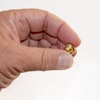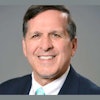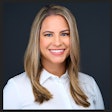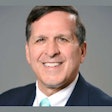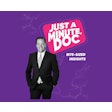

"At times like this, it's tempting to say, 'I'm getting out of it,' " Mark Miller, client relationship manager for AXA Equitable Life Insurance, told DrBicuspid.com. "But by getting out of the funds that involve risk, you're accepting the loss. Six months from now, they could go back up again."
Even small-cap funds, which have taken a pounding in the past decade, can outperform more conservative investments, argued James Russo, one of five presenters at the retirement seminar.
“At times like this, it's tempting to say, ‘I'm getting out of it.’ ”
— Mark Miller, AXA Equitable Life Insurance
Small is beautiful?
"This year is a perfect example of what kind of volatility is in the stock market," said Russo, vice president of the EQ/AllianceBernstein Small Cap Growth Portfolio. "Small cap is more volatile than large cap. As small-cap managers we believe that over five years we will be rewarded."
The fund invests in companies with a capitalization between $100 million and $2 billion. It uses a combination of the managers' experience and quantitative measures to find companies with prospects of rapid growth, said Russo. "We often look for growth to be about 15% or a little better. These are companies that are growing faster than the rest of the economy."
Typically the fund looks for companies that have found a niche no one else is exploiting. "Many of the names you'll see in your portfolio, you're not going to recognize," said Russo. "But hopefully you will recognize them in four years."
Once the companies grow bigger than $2 billion, the fund sells them on the theory that they can't grow much bigger. For example, the fund once owned stock in Starbucks, but sold out when the coffee house chain was no longer a small-cap company.
Over the past decade, the fund has about kept pace with its benchmark, the Russell 2000 Growth Index. Since its inception in 1997, the fund has yielded an annual return of 7.37%, versus 7.13% for the Russell. But in recent months, the fund has lagged the Russell.
The index file
Could investors do better without paying managers who try to outguess the market? Judy DeVivo, senior vice president for the EQ/Equity 500 Index and EQ/Small Company Index, presented that argument.
Index funds, she explained, attempt to mirror one of the indexes used to show how sectors of the market are performing. Investors who read, for example, that the Standard & Poor's (S&P) 500 is up 5% can know that their investment in that fund is up by a similar percentage.
"With an index fund, you get no surprises," said DeVivo. "If you have contracted for an S&P 500 index fund, you should get the performance of the S&P 500. It's that simple."
Index funds, however, don't perform quite as well as the actual indexes because they must subtract management costs from the returns. "It's our job in passive management to minimize those costs so that you have little or no impact on performance," DeVivo said.
Since its inception in 1997, the EQ/Equity 500 Index portfolio has yielded an annualized return of 8.81%, versus 9.23% for the S&P 500, which it tries to mirror.
The Small Company Index, which tries to match the Russell 1000, has yielded 3.31% since April 30, 2008 (when the fund became available through the ADA). Its benchmark yielded 3.73%.
Striking a balance
For those investors who don't want to fuss about the right balance to achieve diversity in their investments, the ADA program offers AXA Allocation Portfolios, said Kenneth Kozlowski, who manages these investment tools for the ADA program.
Essentially, the Allocation Portfolios are funds of funds. Depending on how quickly the investor needs the money -- the investment "horizon" -- the program offers portfolios weighted to various proportions of stocks and fixed income securities, such as Treasury bonds.
The funds are regularly rebalanced. When stocks do well, growing to make up a higher percentage of a given fund, the managers sell stock until the fund is balanced according to the proportions originally intended.
"We have a very disciplined balancing strategy," Kozlowski said. "In the past year, we have rebalanced several of our funds out of fixed income into equities because our triggers were hit. In the past couple of years, we did the opposite."
Safe harbor
The balance of investment instruments is only one consideration for investors, though, Miller said. Dentists need to choose how best to shelter their income from tax collectors as well.
In recent years, a variety of 401(k) plans have become available. The original type, designed for large companies, may not benefit the small practice run by most dentists, Miller said.
One problem is that traditional 401(k) plans limit the amount the employer can contribute based on how much employees contribute. For dentists with no employees, a Simple 401(k) may be the best option.
But for the more typical practice, with an average of five employees, the best option might be the Safe Harbor 401(k), Miller said. In 2007, employers could contribute up to $15,500 of their own income using this plan, regardless of employee participation.
Such technicalities have taken on a new importance as many dentists reevaluate their options because of the recent plunge in the stock market.
Retirement may not come as soon as expected, for some, Miller acknowledged. And he advised dentists to look at the long-term. "People have a misconception that the day they retire all that money is going to be used," he said. "You're going to start drawing on the money when you're 65 or 66 years old, but you're going to be drawing on it, god willing, for 20 years after that."
